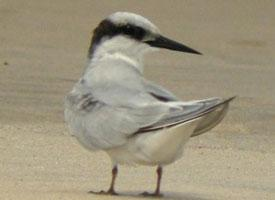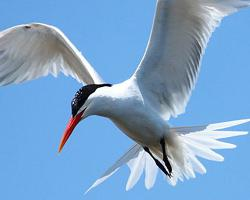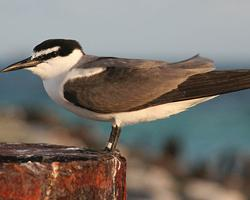
Starea de conservare
| Amenințat |
Descrierea animalului
The Damara tern, scientifically known as Sternula balaenarum, is a small, yet fascinating bird that belongs to the Laridae family, which encompasses gulls, terns, and skimmers. This species has captured the interest of birdwatchers and conservationists alike due to its distinctive features, behavior, and the challenges it faces in its natural habitat.Physical Characteristics:
The Damara tern is a diminutive bird, measuring about 23 to 25 centimeters in length, with a wingspan that typically extends around 50 to 55 centimeters. Its appearance is characterized by a slender body, a short neck, and a relatively small head. The bird boasts a sharp, pointed bill that is black with a yellow tip, a feature particularly noticeable during the breeding season. Its legs are short and are a strikingly bright orange color, which contrasts with its predominantly pale plumage. The upper parts of the bird are a soft, light gray, while the underparts are predominantly white. A distinguishing feature of the Damara tern is the black cap on its head, which extends down to the eyes, giving it a masked appearance. During the breeding season, the black cap is more pronounced.
Habitat and Distribution:
The Damara tern is primarily found along the coasts of southwestern Africa, with its range extending from Angola down through Namibia to the western parts of South Africa. It prefers coastal habitats, especially sandy beaches, estuaries, and lagoons, where it can find ample food and suitable nesting sites. Unlike many other tern species, the Damara tern often nests and feeds in areas far from human habitation, which has made studying and conserving this species particularly challenging.
Behavior and Diet:
The Damara tern is a migratory bird, with many individuals traveling northwards after the breeding season to spend the non-breeding period in regions extending as far north as the Democratic Republic of the Congo and Gabon. This bird is a skilled hunter, primarily feeding on small fish and invertebrates, which it catches by performing elegant dives into the water from heights of up to 10 meters. Its diet and hunting techniques underscore the bird's adaptation to its coastal environment.
Breeding:
Breeding season for the Damara tern occurs from October to December, during which time pairs become highly territorial. They nest on the ground, often in sparsely vegetated areas, where they lay one to two eggs. The nests are simple scrapes in the sand, which offer little protection to the eggs or chicks from potential predators or the harsh environment. Both parents share the responsibilities of incubating the eggs and feeding the chicks until they are ready to fledge.
Conservation Status:
The Damara tern is classified as Near Threatened by the International Union for Conservation of Nature (IUCN). The species faces several threats, including habitat loss due to coastal development, disturbance by human activities, and predation by introduced species. Efforts are underway in several parts of its range to protect critical nesting sites and to mitigate the impacts of human activities on this delicate bird's habitat.
The Damara tern, with its distinctive appearance, intriguing behavior, and the challenges it faces, is a symbol of the fragile beauty of our planet's coastal ecosystems. Its survival is intricately linked to the health of its habitat, making it a sentinel species for the conservation of coastal environments.
Animale similare
Fotografii noi cu animale
Top 10 animale
- Diana monkey (Cercopithecus diana)
- Dolphin gull (Leucophaeus scoresbii)
- Galápagos tortoise (Geochelone nigra complex)
- Moustached guenon (Cercopithecus cephus)
- Japanese spider crab (Macrocheira kaempferi)
- Colossal squid (Mesonychoteuthis hamiltoni)
- Fox tapeworm (Echinococcus multilocularis)
- Stone loach (Barbatula barbatula)
- Japanese macaque (Macaca fuscata)
- Barbary macaque (Macaca sylvanus)


